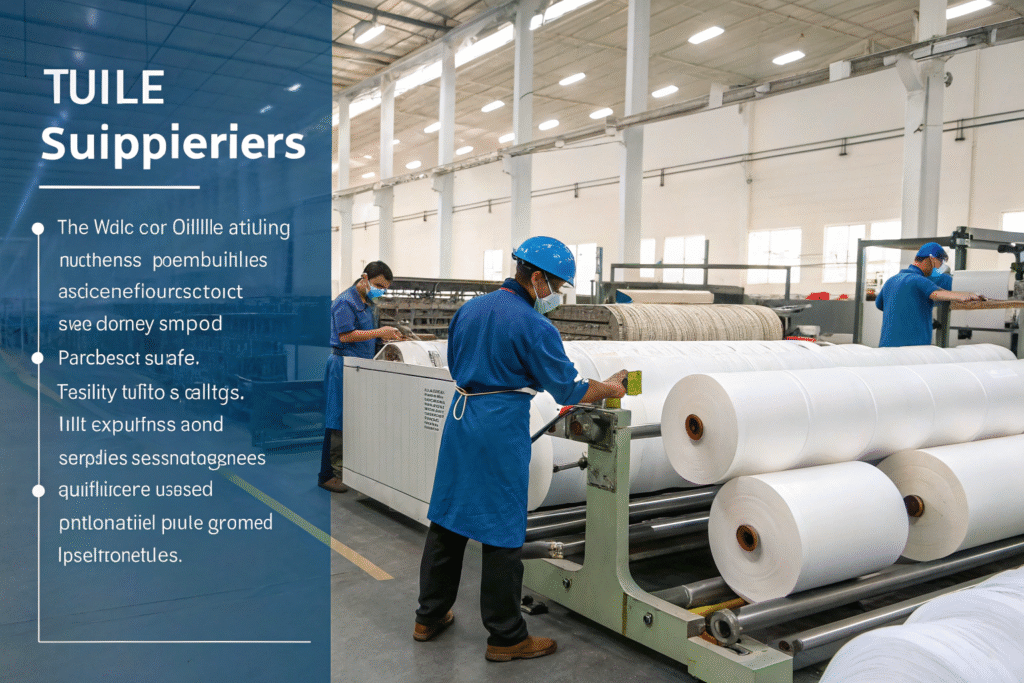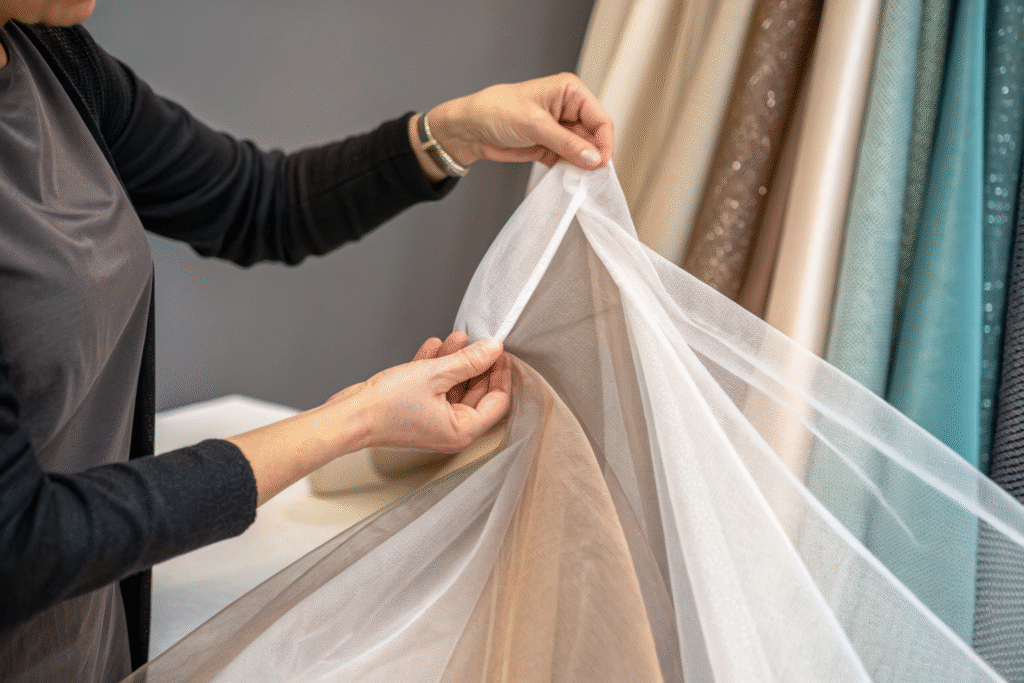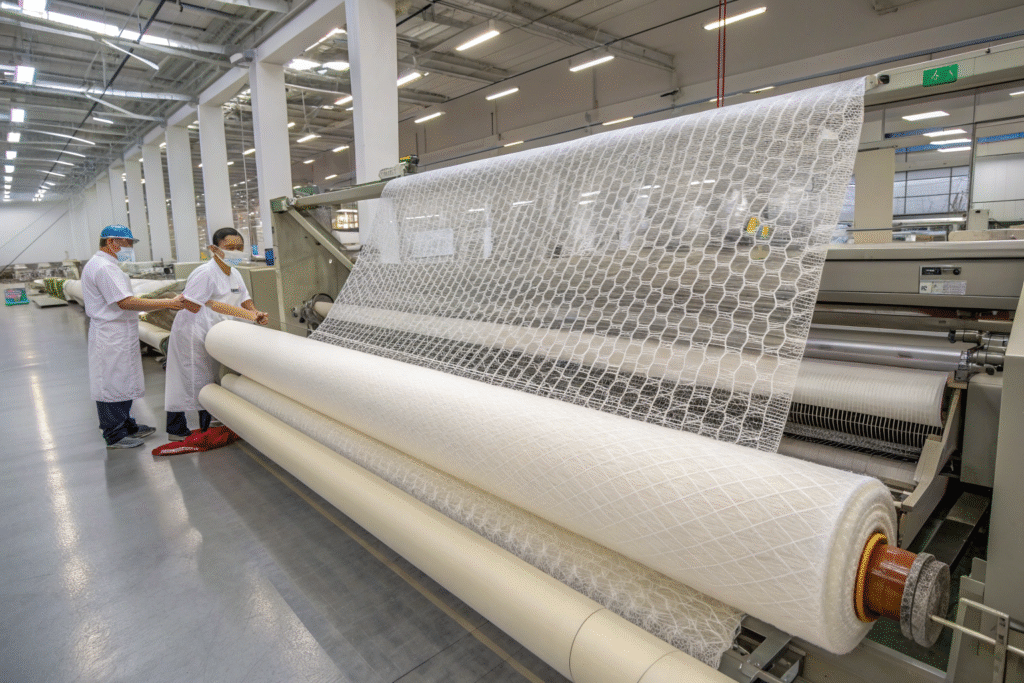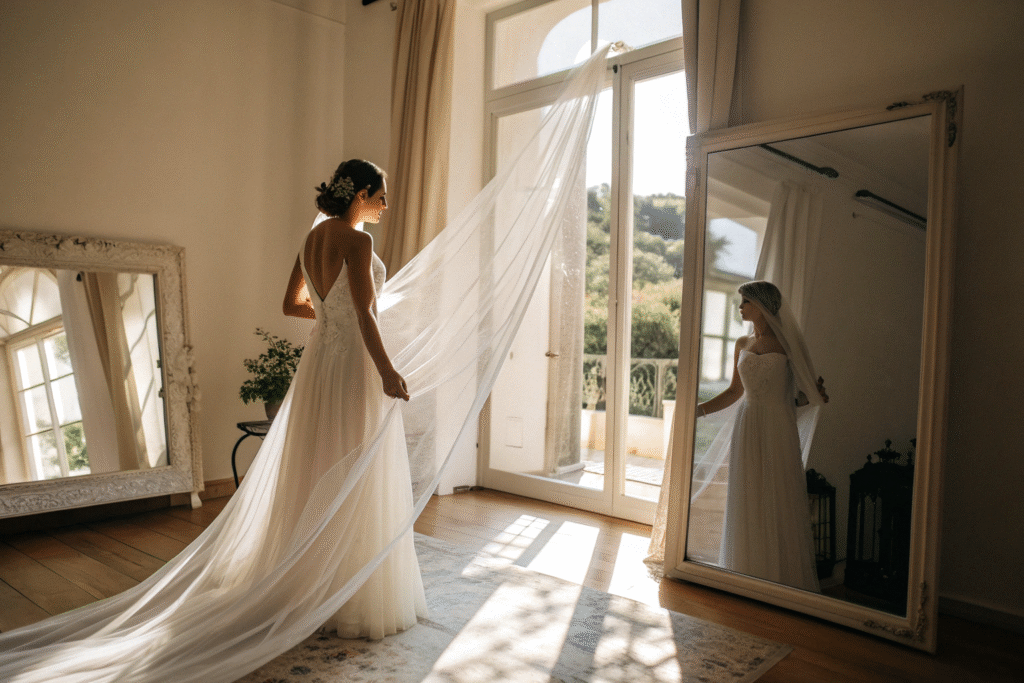As an established textile manufacturer with extensive experience in the bridal fabric sector, we frequently address inquiries regarding tulle specification for wedding attire. The selection process involves balancing aesthetic requirements with practical considerations to ensure optimal performance throughout the wedding occasion. Understanding tulle's fundamental characteristics enables designers to make informed decisions that align with their creative vision and quality standards.
Tulle represents a fine netting textile characterized by its distinctive hexagonal mesh construction. While traditionally manufactured from silk fibers, contemporary production primarily utilizes nylon, polyester, or rayon filaments. For bridal applications, the optimal GSM (Grams per Square Meter) typically ranges between 50-100. Lighter weight tulle (50-70 GSM) demonstrates exceptional drape characteristics for veils and overlays, while medium weight variations (80-100 GSM) provide enhanced structural integrity for sculptural elements like ball gown skirts.
The selection criteria extend beyond basic weight specifications to include fiber composition, construction methodology, and finishing treatments. These elements collectively influence the final garment's performance, durability, and visual appeal.
What are the primary fiber compositions in tulle manufacturing?
The fundamental properties of tulle are largely determined by its fiber content. Different materials offer distinct advantages in terms of cost structure, performance characteristics, and luxury quotient. This decision directly impacts the garment's pricing strategy, maintenance requirements, and tactile experience for the end consumer.
Contemporary tulle production predominantly utilizes synthetic polymers, with nylon and polyester representing the industry standards. Nylon tulle exhibits superior tensile strength and elastic recovery, making it suitable for applications requiring dimensional stability. Polyester tulle offers economic advantages while demonstrating enhanced resistance to wrinkling and shrinkage. For premium segments, silk tulle remains the benchmark for luxury, characterized by its natural luster and superior drape coefficient, though it commands premium pricing and requires specialized care protocols. Cotton tulle, though less prevalent, provides a matte finish and enhanced softness.

How does fiber selection influence drape and hand feel?
The drape characteristics and hand feel of tulle are intrinsically linked to fiber composition. Silk tulle demonstrates exceptional drapeability, moving fluidly with the wearer's movements while maintaining a luxurious tactile experience. Polyester variants may exhibit greater stiffness, which can be advantageous for architectural silhouettes requiring structural integrity. Recent advancements in fiber engineering have enabled the production of premium polyester tulles that closely approximate the hand feel of silk, providing cost-effective alternatives without significant compromise on comfort parameters. We recommend obtaining fabric swatches for tactile evaluation during the material selection phase.
What are the performance characteristics of different tulle materials?
A comprehensive understanding of material properties facilitates informed sourcing decisions. The following comparison outlines key performance metrics:
| Material | Advantages | Limitations | Optimal Applications |
|---|---|---|---|
| Silk | Superior drape, luxury hand feel, natural fiber origin | Premium cost structure, delicate construction, specialized care requirements | Haute couture bridal gowns |
| Polyester | Cost-effective, wrinkle resistance, durability | Reduced softness, synthetic composition | Commercial collections, structured designs |
| Nylon | High tensile strength, excellent elasticity | Potential photodegradation, reduced breathability | Veils, reinforced overlays |
| Rayon | Soft hand, good drape, cellulosic base | Reduced wet strength | Blended constructions, sustainable lines |
Material selection should align with design objectives and price positioning. The luxurious drape of silk charmeuse for linings or the structural performance of polyester-nylon blends for skirts represent different strategic choices. For environmentally conscious collections, we offer tulle manufactured from recycled polyester, maintaining performance standards while addressing sustainability concerns.
What manufacturing techniques are employed in tulle production?
The distinctive net-like appearance of tulle results from specialized manufacturing processes. As a lightweight, open-construction textile, tulle can be produced through either weaving or knitting methodologies. The manufacturing technique directly influences the fabric's structural stability, weight distribution, and volume characteristics, all critical factors in bridal wear applications.
Tulle is predominantly manufactured on specialized looms utilizing a weaving technique that generates the characteristic hexagonal mesh configuration. The weaving process involves precise yarn twisting that provides structural stability to the delicate network. Mesh density can be calibrated during production—reduced aperture size creates higher opacity, while enlarged openings enhance airiness and reduce overall weight. Warp knitting represents an alternative production method, frequently employed for elastic tulle constructions that incorporate spandex for enhanced stretch properties, particularly valuable for fitted bodices and sleeve applications.

How do woven and knitted tulle constructions differ?
The structural differences between woven and knitted tulle significantly impact performance characteristics. Woven tulle, representing traditional manufacturing approaches, demonstrates exceptional stability and minimal stretch, making it ideal for volume-intensive applications like layered skirts. Knitted tulle, produced through interlooping yarn systems, inherently incorporates stretch properties. This stretch tulle has gained prominence in contemporary bridal design for its ability to provide comfortable, form-fitting silhouettes. Technical packages should clearly specify the required construction method to ensure desired performance outcomes.
How does mesh density affect bridal tulle performance?
Mesh density, or aperture size within the net structure, represents a critical specification parameter influencing opacity, weight distribution, and visual aesthetics. Finer mesh configurations create subtle visual effects with enhanced coverage, suitable for veil applications and skin-contact layers. Larger, more pronounced mesh patterns create bold visual statements while contributing to reduced GSM measurements, ideal for voluminous skirts requiring maximum fullness with minimal mass. Design considerations should account for interaction between mesh size and underlying layers, such as satin foundations, to achieve targeted visual effects.
What GSM parameters optimize wedding veil performance?
The veil represents a critical aesthetic component in bridal ensembles, where movement characteristics take precedence. GSM selection for veils prioritizes ethereal drape properties over structural requirements. A veil with excessive mass will lack fluid movement, while insufficient substance may compromise manageability and visual presence.
For traditional flowing veils, GSM parameters between 40-60 generally provide optimal performance. This ultra-lightweight tulle category demonstrates exceptional suppleness, enabling elegant draping over the bride's silhouette with graceful trailing characteristics. A 50 GSM tulle typically offers ideal balance—maintaining sufficient body for shape retention while remaining responsive to atmospheric movement. Heavier constructions exceeding 70 GSM tend toward rigidity, better suited to structured styles like birdcage veils.

How does GSM influence cathedral veil drape dynamics?
GSM directly correlates to mass and consequently determines drape behavior. Extended cathedral-length veils manufactured from low-GSM tulle (45-55 range) exhibit soft, fluid folding patterns and responsive movement during locomotion. Equivalent lengths produced from higher-GSM materials demonstrate more pronounced folding and increased tension at attachment points. Design specifications should align GSM with veil dimensions and dramatic intent. Illusion tulle with fine mesh construction and reduced GSM frequently serves as the preferred substrate for achieving ethereal visual effects.
Can layered GSM configurations enhance veil design?
Strategic layering of different GSM tulles enables advanced design possibilities for volume and texture modulation. A common technical approach employs moderately heavier tulle (60-70 GSM) for the crown-attachment layer, providing structural foundation, while suspending lighter constructions (≤50 GSM) beneath to create fluid train elements. This methodology produces veils with defined structure transitioning to floating extensions, allowing significant design customization prevalent in haute couture collections. We recommend evaluating fabric swatches across multiple GSM values to assess layering interactions during development phases.
How should tulle be specified for structured bridal gowns?
While veil applications prioritize fluidity, primary gown constructions often require tulle with enhanced structural capabilities. Architectural silhouettes such as ball gowns and A-line designs depend on tulle that provides internal support and shape retention throughout extended wear periods. The selection objective involves identifying tulle that offers sufficient body without introducing excessive mass or rigidity, ensuring wearer comfort and mobility.
For structured gown classifications, medium-weight tulle ranging from 80-100 GSM typically delivers optimal performance. This weight category provides adequate stiffness and structural integrity to maintain skirt silhouettes, often over internal foundations, without significant mass accumulation. The material demonstrates sufficient robustness for dense gathering and layering applications while preserving the lightweight characteristics essential to bridal aesthetics. Some designers specify 120 GSM tulle for dramatic architectural forms, though we recommend thorough comfort testing as reduced flexibility may impact wearability.

What function does tulle serve in multi-layered skirt engineering?
In multi-layered skirt constructions, tulle operates as both volume-generating and structural component. Individual layers contribute cumulatively to overall fullness and silhouette definition. Standard practice utilizes stiffer, higher-GSM tulle for foundational layers proximate to the body, while employing softer, lower-GSM variations for exterior layers to refine surface aesthetics. The quantitative relationship between layer count and individual GSM values can be precisely calibrated to achieve specific volume targets, from subtle A-line to dramatic "princess" profiles. This layered methodology represents a hallmark of quality bridal wear manufacturing, requiring meticulous planning during pattern development and sampling stages.
What design considerations ensure comfort in substantial tulle gowns?
Comfort optimization in structured tulle gowns requires integrated design and material selection strategies. Primary considerations include selecting tulle with appropriate stiffness without abrasive characteristics; soft cotton blend tulle may be specified for innermost layers. Construction methodology proves equally critical—skirt mass should be properly distributed through engineered internal structures like waist stays to prevent bodice strain. Finally, operational features like bustle systems manage train elements post-ceremony. Our quality control protocols verify these comfort-oriented details throughout the garment manufacturing process to ensure final products balance aesthetic and functional requirements.
Conclusion
Tulle specification for bridal applications requires systematic evaluation of multiple technical parameters. Successful selection depends on understanding the interrelationship between GSM, fiber properties, and construction methods to achieve fabrics that satisfy both design vision and practical wearability. The optimal bridal tulle cannot be defined by isolated specifications but rather by how its combined characteristics align with specific application requirements, whether for flowing veils or architectural gown structures.
This technical overview provides foundational knowledge for informed fabric selection in bridal collections. For designers seeking to develop wedding attire with precision-specified tulle substrates, we offer comprehensive support from material development through production delivery. We invite collaboration to transform design concepts into realized garments. For technical consultation regarding your specific fabric requirements, please contact our Business Director, Elaine, at elaine@fumaoclothing.com. Our organization remains committed to serving as your technical partner in bridal textile innovation.










